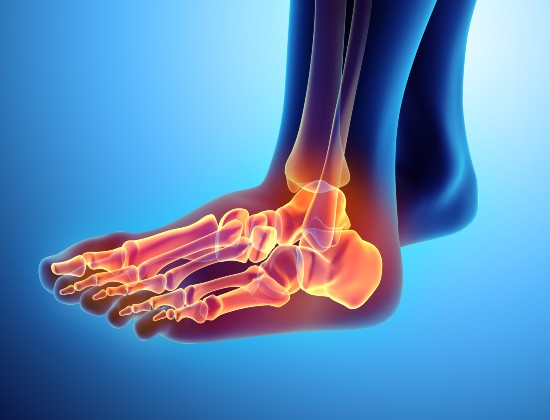Stress fractures
A stress fracture, or small crack in the bone of the foot or lower leg, is usually caused by overuse of a limb. The muscles become tired and don’t absorb the shock of impact caused, for example, by the repeated stress of using the foot the same way over and over again.
How does a stress fracture usually happen?
Stress fractures normally occur in athletes who change their training habits or intensity. Running on unfamiliar hard surfaces, sudden increases in activity levels and activities that put pressure on the feet including running, jumping, or dancing can make injuries more likely.
Which athletes are most likely to develop stress fractures?
You are more likely to have a stress fracture if you:
- Take part in high impact sports such as track and field athletics, tennis, gymnastics, dance, long distance walking or football
- Change your training habits or the intensity of your training
- Have abnormal foot posture and movement when running
- Wear the wrong type of shoes for your sport
- Run on hard surfaces
- Have osteoporosis, or a hormone imbalance that reduces the mineralisation of the bones and their ability to withstand repetitive stress
Why might women have more stress fractures than men?
Female athletes who have irregular periods are more likely to develop stress fractures due to reduced or erratic oestrogen hormone production which normally helps with bone strength. An extreme example of this is where a woman has a combination of factors including an eating disorder, not having periods, and osteoporosis (low bone density).
Which areas are most prone to stress fractures?
The vast majority of stress fractures occur in the foot and lower leg, most commonly in:
- The shin bone (tibia)
- The metatarsal bones in the foot
- The calf bone (fibula) or lateral malleolus at the ankle
- The shin bone (tibia) or medial malleolus at the ankle
- The heel bone (calcaneum)
- The navicular bone in the foot
- The ankle (talus) bone
- The sesamoid bones under the big toe, sometimes known as a turf toe injury
What are the symptoms?
Symptoms include pain in the area of the suspected fracture. The pain gets better when you rest but starts again when you use the affected limb.
Many people don’t realise they have a stress fracture, and can’t remember hurting themselves. However, if you suspect you may have a stress fracture, or have ongoing pain without an obvious cause, you should contact the Fortius Clinic for advice.
How is a stress fracture diagnosed?
If the stress fracture is very recent then X-rays may not show the problem until around three weeks after symptoms begin. You may be offered an MRI scan, which can show the injury in more detail.
How is it treated?
Treatment varies depending on the symptoms:
Non-operative treatment: this involves complete rest from running or other high impact activities. You may be given a plaster cast or rigid boot and crutches, and repeated examinations and follow-up MRI scans can check healing. As symptoms improve, you can gradually resume training but in the meantime aerobic activity can be maintained by other exercises, for example swimming, deep-water running or cycling
Surgery: if you are hoping to return to sports quickly, you may be offered surgery early on, especially if you have one of the following:
- Medial malleolus fracture (a fracture of the inside of the tibia)
- 5th metatarsal fracture
Getting back to normal
Most stress fractures heal between one and three months. However, if the fracture worsens or you return to activity too early, you will need to rest for longer. If you continue to be in pain, you may be offered shockwave therapy or surgery to stabilise the fracture (a pin or plate may be fitted). Some athletes choose surgery if they think other therapies will take too long, but this can be discussed with your surgeon.
Preventing stress fractures
To avoid stress fractures in the future:
- Be sensible in your training goals; don’t push too hard or too quickly
- Vary your training between high impact training, such as running, with lower impact training such as cycling
- Prepare well and make sure you have a healthy diet
- Make sure you are well equipped with the correct shoes for your sport
- If you experience pain or problems don’t push it. Rest and gradually restart. If you are still in pain, contact the Fortius clinic for advice
Important: This information is only a guideline to help you understand your treatment and what to expect. Everyone is different and your rehabilitation may be quicker or slower than other people’s. Please contact us for advice if you’re worried about any aspect of your health or recovery.


